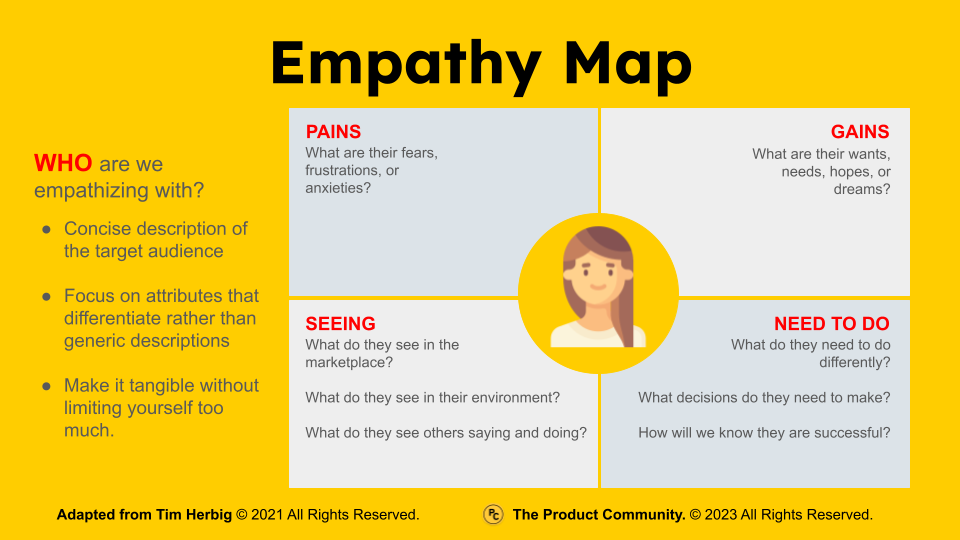Summary
“Chase the vision, not the money.”
Tony Hsieh
In an ever-evolving, complex world, it’s important to define a vision that everyone buys into and works toward. This is true for org-wide visions and visions created for products or offerings.
An association product can be anything as simple as a podcast, webinar, simple game, or short course; it can be as complex and multifaceted as a piece of software or a carnival-like, choice-driven vehicle like an annual event.
All products need a vision. This article will dig into different approaches to create a product vision that is exciting, aligned, usable, and widely-owned.
The Product Community is a product development learning community designed specifically for associations.
A Singular and Exciting Future
“Vision is the true creative rhythm.”
Robert Delaunay
Vision is the compelling description of a successful outcome. Great visions drive focus and push our energy around a singular and exciting future.
An organization-wide vision acts like a guiding light, steering everyone towards a common goal. Associations need them at the org-wide level but also for each product the association offers. Here are the main reasons why:
Unity of Purpose: A shared vision aligns everyone from leaders to members, toward a singular objective. It helps us make good decisions and prioritize actions that move us forward.
Inspires Action: A compelling vision motivates people. It gives reason to invest time, skills, and efforts into the mission, creating a sense of purpose and belonging.
Clarity and Focus: With a clear vision, everyone understands what we’re working towards. It provides direction, preventing distractions and ensuring effective resource use.
Stakeholder Engagement: A strong vision resonates with stakeholders —members, sponsors, the community, etc. — allowing them to see our value and potential impact. Visions can attract support and drive collaboration.
Measuring Progress: The vision is a yardstick for success. It allows us to track progress, evaluate achievements, and adjust strategies as needed.
Adaptability and Resilience: In a changing world, a well-defined vision enables resilience and helps us adapt while staying true to our core values.
Long-Term Sustainability: A clear vision innovation and provides a roadmap for the future, ensuring we remain relevant and impactful.
One approach to developing a vision is derived by answering these questions:
What problem does my association seek to solve?
Why do we believe this problem needs to be addressed?
Does this problem matter to our current or prospective members?
What business are we in? What business are we not in?
What are the greatest strengths of our association?
What makes us special and unique? What are our differentiators?
What is our dream for this association?
How would things be different if our dream came true?
Does our dream connect on a personal level with others?
What is our winning aspiration? What does success look like?
The concept and process used for an association-wide vision is similar to how to derive a product vision, whether for say for an annual conference, monthly journal, or learning game. Another way to capture a product vision is to use the formula developed by Geoffrey Moore in his book Crossing the Chasm:
For (target customers)
Who are dissatisfied with (the current market alternative)
Our product is a (new product category)
That provides (key problem-solving capability).
Unlike (the product alternative),
We have assembled (key feature for your specific product).
Moore’s approach describes who the product is for and how it differs from competing offerings. A third approach is to utilize Roman Pichler’s Product Vision Board that aligns your product vision to your product strategy.
By digging into our reason for creating the product plus the positive change it could create, we can begin to describe a product vision. Here, the product vision is closely aligned to the product strategy. One way of sketching our strategy is to fill out this vision board (Another more in-depth way to follow the process laid out in my article Playing to Win: A Guide to Strategic Advantage for Associations and Nonprofits).
In doing so, we describe the target audience, the problems the product looks to solve, a description of the product, and how the product will benefit the association and members plus the desired benefits to the business.
A Great Vision Attracts Like a Magnet
“A vision is not just a picture of what could be; it is an appeal to our better selves, a call to become something more.”
Rosabeth Moss Kanter
A great vision is specific enough to result in deep ownership and extend to everyday practice. It attracts like a magnet. This is especially true when individual product visions are aligned with the association’s broader vision and organizational priorities.
It’s important to be focused when developing a vision; it helps us position a new product or program to solve particular problems for a particular audience. Being too broad (“all things to all people'') under the premise of unfettered access to as many markets as possible is a common trap.
This ‘spray and pray’ approach results in needless commoditization of our core value driven by an oatmeal-like, general vision. While it’s nearly impossible to predict the future, it is possible to describe the future in a way that is clear, focused, and based firmly in community.
In addition to what we’ve reviewed here, there are many other tools that can be used to help develop a vision: the ideal state outcomes (ISO) exercise (see my article Finding Your North Star), the Business Model Canvas (see my article How to Design a Winning Business Model), or the empathy map (see graphic from Tim Herbig).
The empathy map is powerful as it pushes you to think deeply about our members, what they care about, and what problems they need solve. It helps us create a human-centered vision that’s easy for everyone to rally around with deep emotional commitment.
Great Visions Bring People Together
“Vision is a destination – a fixed point to which we focus all effort. Strategy is a route – an adaptable path to get us where we want to go.”
Simon Sinek
Vision defines a shared future and can be a great way to build and propel a vibrant community and a healthy culture. Like I said earlier, it’s important to define a vision everyone buys into, believes in, and works toward.
Successful, forward-looking organizations do these two things well: (1) spend the time to identify a unique vision and (2) design their association and product offerings so the vision is top-of-mind and embedded in our day-to-day activities.
In this way, the vision offers clear direction when creating the things people love. The outcome is deeper connection, sustained engagement, and diversified revenue.
Remember, product-led growth fuels connection. Join the product community and flip your destiny.
About the Author
James Young is founder and chief learning officer of the product community®. Jim is an engaging trainer and leading thinker in the worlds of associations, learning communities, and product development. Prior to starting the product community®, Jim served as Chief Learning Officer at both the American College of Chest Physicians and the Society of College and University Planning.
Please contact me for a conversation: james@productcommunity.us.







